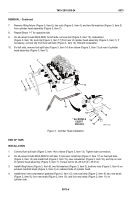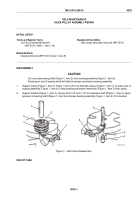TM-9-2815-205-24 - Page 466 of 856
TESTING
1.
Air pump
CAUTION
Do not exceed 18 volts direct current on air pump. Excessive voltage will overspeed
air pump and damage pump vanes.
NOTE
Install vanes, plate, and screws in air pump before testing.
Use fabricated test lead (Figure 2, Item 16) to reduce a 24 V dc power source
to 18 V dc. Connect test lead in series with positive terminal of power source.
a.
Connect an 18 V dc power source to air pump (Figure 2, Item 7). Connect positive lead to terminal
(Figure 2, Item 18) marked (+) and negative lead to unmarked terminal (Figure 2, Item 17).
NOTE
Use digital multimeter to measure amperage. Adapt pump outlet to fit a tire pressure
gage or other suitable measuring device to measure air output pressure.
b.
Measure air pressure and amperage. Air pressure at outlet port elbow (Figure 2, Item 15) must
be a minimum of 10 PSI at 18 V dc. Pump must draw a maximum of 25 amperes.
c.
Remove power source from terminals (Figure 2, Item 17 and 18).
16
17
18
15
7
24 V DC
+
MAINT_205
Figure 2.
Air Pump Testing.
2.
Ignition coil and igniter
NOTE
Ensure high tension wire used for testing is in good condition.
a.
Connect high tension lead (Figure 3, Item 23) to ignition coil (Figure 3, Item 4) and fuel
igniter (Figure 3, Item 21).
b.
Connect air heater assembly (Figure 3, Item 22) and ignition coil (Figure 3, Item 4) to common
ground (Figure 3, Item 19).
TM 9-2815-205-24
0074
0074-4
Back to Top




















